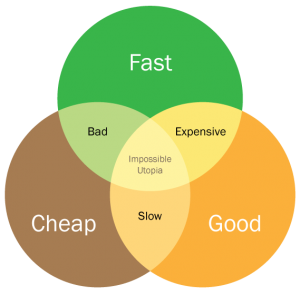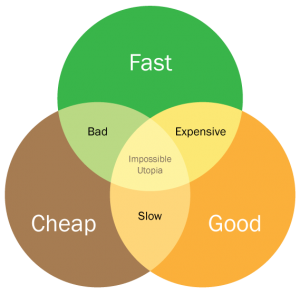Working as the Creative Director in a print shop like Casey, I have been a first-hand witness to every kind of file submission known to man, from PDF to Publisher, created by every production method, from professional design firm to a friend with a Mac. All of them have one thing in common: best value at the best price. Unfortunately, sometimes “going cheap” can cost you a lot more than you think. So in an effort to uncloak the hidden costs associated with designing on the cheap, I bring you this week's Casey Connect.
Businesses That Don't Profit Don't Survive
First let's cut to the chase: No one is in business to lose money. No one. Sure, you may really believe in what you do and have a vision and a dream that drives the core of your business's mission and values — most good businesses do — but without a profit margin rent won't get paid and the business will close. To keep that profit margin healthy, responsible businesses are always looking for ways to cut costs without compromising the value of their product or services, and one of the areas they often look to is creative services. Companies want to get the job done without breaking the bank, and creative services can be very expensive. Unfortunately, investing too little in creative services can result in increased printing costs and adversely affect your profit margin — the exact opposite of your desired result.
Photoshop Does Not a Designer Make
Did you ever wonder why there were so many college courses for the Graphic Design trade, or what the point of an AA, BA or Masters degree in Graphic Design was? Graphic Design is a skilled trade that requires a formal education and years of experience to mold into a career. Sure your cousin Joe may be handy with a hammer and know how to patch a hole in your wall, but would you want him to build your house? Hiring a “design hobbyist” on the cheap will end up costing you in endless revisions, poorly setup files, and ineffective communication of your company's message. The first two will result in expensive service charges, while the third can be a business killer. Just because someone owns a Mac or has Photoshop installed on their computer, don't mistake them for a designer. Not everyone who owns a hammer is a carpenter.
Your Designer Needs Tools
Just because Photoshop doesn't make someone a designer doesn't mean your designer doesn't need Photoshop. In fact, they'll probably need Illustrator, InDesign, Acrobat Pro, and if they manage your website, Dreamweaver, too. These are the industry standard tools for the trade. Sure you may already own an old copy of Publisher, PageMaker or Word, but using these tools will result in sub-par design and extra charges to fix the files for professional printing.
“But My Designer Doesn't Know How to Use Adobe”
If your current designer doesn't know how to use the Adobe suite of tools, then their education may be in sore need of an update. Adobe has been the undisputed industry standard for Visual Communications since the very beginnings of desktop publishing in the late eighties, and this is even more true today as they've displaced former competitors such as Quark and Macromedia.
“But I Have an Already Paid for Copy of Photoshop 6, and It Works”
A major deterrent to a company's use of modern software (and to their staff learning how to use it) is the perceived frugality associated with “getting your money's worth” out of software you already own. Unfortunately, there does come a point at which the money you save by using outdated software is completely overshadowed by the money you waste in additional charges, labor, unnecessary back and forth, workarounds and file conversions (not to mention lost customers). It's the difference between giving someone sugar to sweeten their tea, or giving them sugarcane. The result is the same, but one requires extra costly and time-consuming processing.
The money you invest in newer software will more than pay for itself, and it will be one less headache on your plate. I recommend you have a look at your workflow this week and find out if your getting the best value for your investment.
I hope you enjoyed reading about the real cost of designing on the cheap. If you have any thoughts or questions about today's topic, or if you want to learn more about how investing in software and skilled creatives can save you money, feel free to drop me a message in the comments box below or on our Facebook, Twitter, Google+ or Contact Page. Keep in touch, and thanks for reading!




